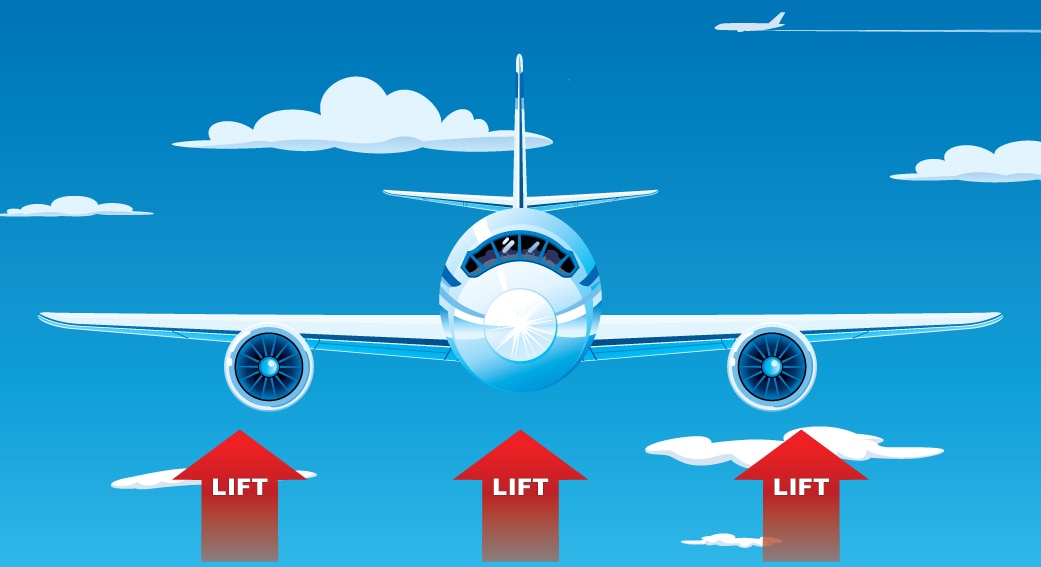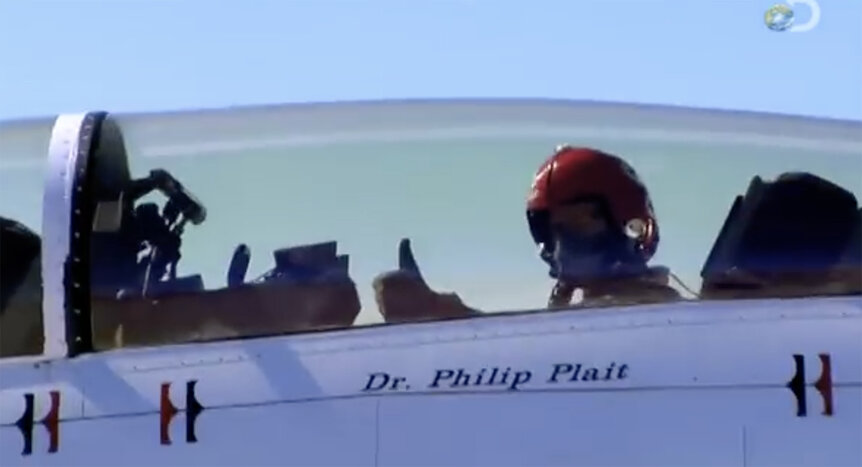Create a free profile to get unlimited access to exclusive videos, sweepstakes, and more!
What causes lift?

Yesterday, I wrote about one of my favorite kinds of clouds: Kelvin-Helmholtz clouds, also called fluctus clouds. You can call them wave clouds, because that’s what they look like: waves breaking over a beach.
I also embedded a video from Sixty Symbols explaining them, but during that explanation the scientist, Mike Merrifield, made a bit of a flub: He said that with an airplane wing, lift is generated because air is moving faster over the top of the wing than the bottom. This lowers the pressure over the wing, so the force under the wing is higher. That pushes the plane up.
That part is true, but he also said that the reason the air moves faster is that it has farther to travel over the curved wing than the air moving under the wing, where the wing is flat. To meet up with its counterpart packet of air, the air over the wing must move faster.
But this isn’t really the case! This is a very common fallacy, sometimes called the “equal transit time fallacy.” As soon as I saw the video I contacted Dr. Merrifield about it, and he said he was creating a follow-up video about lift to correct this misconception. And now it’s out! Watch:
This whole video fascinates me. First, it’s lovely to see a scientist publicly correct himself over an error. That, my friends, is science. Science is all about understanding the real world. Mistakes get made, and if you don’t own up to them and correct them then you’ll never learn what’s really going on.
If only politicians understood this.
I also liked his explanation of what really goes into generating lift. It’s actually a combination of three relatively simple ideas (conservation of mass, momentum, and energy), each of which isn’t too hard to grok individually — everyday experience living on Earth gives most people an intuitive grasp of these concepts. Conservation is just what scientists mean when they say some measurable quantity (like mass) in an isolated system doesn’t change over time. If you take a lump of clay and split it in two pieces, the sum of the weight of those two pieces equals the weight of the original one: That’s a simple way to see conservation of mass.
Same with energy: Whatever energy a system starts with it’ll end with, too (though you can lose some due to things like entropy; but if you include all that then energy in = energy out). Momentum conservation is again the same idea: If you take a mass and let it hit some other mass, some of the momentum will be transferred, but in the end you can’t get more out than you started with (unless you add energy to the system, but then it’s no longer isolated and you have to account for that).
Lift gets tricky because it uses all three and they affect each other. Worse, the way air flows is ridiculously complex due to turbulence and other factors; hydrodynamics tends to get hard fast. That’s probably why people have a hard time with this. Most folks want simple explanations, but if you oversimplify this situation, only looking at one of the components, the explanation falls apart. You need all three.
After I watched the video I was thinking about all this, and it suddenly occurred to me: Does this have anything to do with the old "airplane on a conveyor belt" problem?
If you haven’t heard of this before, then I’m not sure if you’re lucky because you get to discover it for yourself for the first time, or because you haven’t yet had the brain-crushing headache associated with this old chestnut.
The basic premise is simple: If you put an airplane on a treadmill (or conveyor belt), will it be able to take off?
Sounds simple, right? It’s actually a nightmarish logic problem that gets harder to understand the more you look at it in detail (and I did). A lot of people think the plane cannot take off. But the answer — in the practical, real world — is yes, it absolutely will take off.
But don’t take my word for it. My Close Personal Friend Adam Savage™ did this experiment on MythBusters, and the results may surprise you. They sure surprised the plane’s pilot!
I won’t keep you in suspense: The plane took off.
Honesty time: My first draft of this post had a bunch of details and suppositions and what-ifs and various different scenarios described. It turns out that this really is a ridiculously complicated and subtle problem, and it essentially all boils down to what you mean when you talk about the wheels of the plane spinning on the belt.
However, no matter how I described it I wound up in trouble, so instead I will simply tell you that my friend Randall Munroe has already written the go-to description of all this, and he shows that yes, the plane takes off. Feel free to argue about this as much as you want in the comments below. I will not be joining you. My head still hurts from talking to Randall about it for far too much of his time.
But what about lift? This part made me smile. When I first thought of the airplane problem, for some reason I was thinking about the plane being stationary horizontally, but just lifting up vertically, like a helicopter. If that were what it takes for it to take off, then it would never move. As the Sixty Symbols video shows, you need air flowing over the wing to generate lift. In reality the plane does move horizontally (the propeller or jet takes air in front of the plane and throws it behind, making the plane move forward; that’s Newton’s Third Law of Motion). That means air flows over the wing, and up the plane goes.
So you do need lift to get the plane up into the air, but it comes after the horizontal motion. It’s secondary, and doesn’t really play into the problem physically. Weird. My intuition on this problem was way off, and all over the place. It’s funny: There’s some physics I can grasp pretty quickly, based on experience and book learning. But sometimes it completely fails me. This is one of those cases.
As I said in yesterday’s post, fluid dynamics (technically hydrodynamics) is ridiculously complicated, and it’s very easy to oversimplify it and/or get confused by it. And when some erroneous explanation gets out into the wild it can, like the Kelvin-Helmholtz instability, grow and generate turbulence. Hopefully this new Sixty Symbols video (and the old MythBusters one) will be the go-to explanation for how lift works, and maybe smooth the flow of conversation from here on out.















